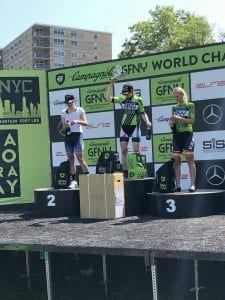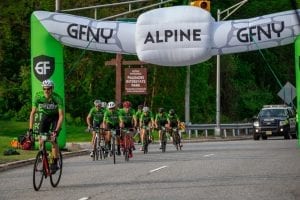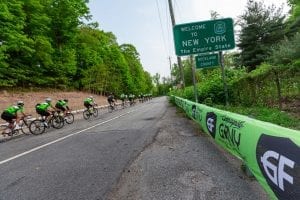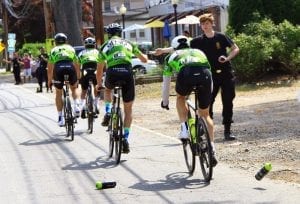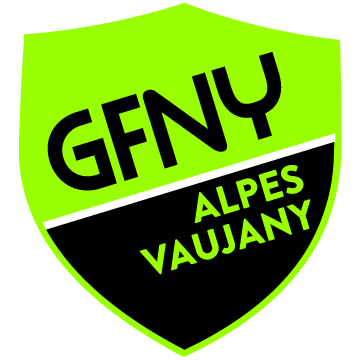Stepping Up — With 2019 GFNY NYC’s World Champion, Jill Patterson
by Chris Geiser
Talking Training, Helping Define Racing, and Keeping it Together on the Final Climb
Jill Patterson celebrates on the Podium at GFNY NYC Championship 2019
364 days. From the fourth Monday in 2018 to the third Sunday in May 2019. The seed was sewn on that fourth Monday in May 2018 to try and take that last step. That last step, to the top step of the podium at GFNY World Championship NYC in 2019. The decision was made to find a way to get there. Jill Patterson had finished second at the 2018 GFNY World Championship NYC — and was not about to settle for that her next time out. But this would be no mean feat. Occupying that step and coming back for more was Colombia’s indominable force, Camila Cortes. 12-time GFNY champion, 5 of those 12 in the GFNY World Championship NYC, Camila would be coming back with the goal of claiming her 13th GFNY title. She would bring a film crew who makes a documentary for Netflix called “Road to 13”.
Something, or someone, would have to give. This would be one for the ages.
Jill staying with the lead group on Cheesecote
We were fortunate to be able to spend some time with Jill to talk about the race, and to talk about racing. Jill’s GFNY story began with her local club team and a teammate who saw her potential to do well. So much so that he and his company were willing to sponsor her. With her new sponsor Pikesville Jewelry covering travel for the race, she was able to start planning and training. She hired herself a coach and got down to business. “I did a 6 month training program with that coach leading up to the 2018 race”, Jill says, “that was the first time I ever trained with a coach. I had intended to go myself in 2019 but my sponsor was taking me very seriously and decided to sponsor me again.” This time, Jill was self-coached.
Thinking back to that first GFNY in 2018, Jill was really impressed with how many strong women there were in the race. But for as impressive as it was, it was also somewhat intimidating. Working to her strong suits she knew that to set herself apart and set herself up for a second attempt to get to the top step, she would have to know how to manage and meter her energy and nutrition, and how to work with others to achieve her goals. Knowing what to expect from the course was a key part of the preparation in both years, and she mad sure that she made her recon efforts pay off.
Staying with her rivals back to 9W
Going to School
That first GFNY in 2018 provided the education that Jill would need going into the race in 2019. Jill watched like a hawk to figure out how the corral start would go, how aggressive it would be up to the climb at Alpine. “I watched in the corral and looked for the skinny guys with the shaved legs, to figure out what wheel to follow out. But Camila’s wheel was the one that I jumped on.” And so the race was under way, and Jill was using her knowledge from the previous year, to know what to expect and how to continue to manage her effort.
“That first year, there was a really decent size group of women — really strong — all the way to Bear! But at Bear, things started to space out. I knew this year, that if I was in the front group as we approached 9W (from the Alpine climb) that probably no one in the pack was going to catch me. And that was right. As we got on to 9W, I knew it was just me, Janine, and Camila, and then I was fairly confident that it would just be the three of us until the end.”
What would be the podium (not in this order) staying together.
Outcomes aside, Jill’s process leading up to the race had to be disciplined and dedicated to being able to provide the best effort in what she could control on race day. “I have been able to structure my life around cycling and that’s why I am a little different than the women that I know. That is a barrier to some approaching this as a serious race.” Jill had noted several times, that she also understood that Camila’s approach was also tempered with a highly disciplined and dedicated approach to training. To match attacks with someone of Camila’s caliber, Jill’s training regimen would have to be able to train her the right way to manage the effort and be able to stay in contact with the front groups.
Because GFNY is an authentic granfondo, with controlled intersection and timed from start to finish, Jill had to train differently than if she was training to win “timed segments” that are sometimes offered as part of bike tours. She would need the ability to endure for an extended period over an extended distance. With competition watching and waiting to go on the attack the minute you show weakness, there would be no respite, no chance to recover, no time to relax until the finish line was crossed.
On 9W with the pack — the work beginning in earnest.
“With other (events that call themselves) granfondos the segments can range from 5- to maybe 20–30 minutes. You need to be able to ride 100 miles but not be able to do it super strong the whole way. I didn’t train to distance, I tried to train for time. To be able to hold a certain tempo for 5 hours. A lot of time working at my sweet spot for extended periods, and then up to threshold. Knowing that it gets harder in the second half you have to have a lot left in you.”
An important lesson and an important distinction. When elapsed time counts, there is no room for aid stations, espresso stops, or pizza. In a race, you race until the racing is done: at the finish line.
Applying the Learning
Jill’s previous GFNY experience and her knowledge of the course told her that she could not win the race on Bear Mountain, but she could certainly lose the race there if she approached it the wrong way. Once again, leveraging her strengths, she knew that staying as steady as possible up the longest climb on the course was critical. As was hanging with the right group to ensure that she would have help past the climb. With a group of 40–50 people staying together halfway up Bear, the surges began.
“Looking back, you can see in my data that I was trying to keep up, but I couldn’t. I was able to stay with the second group, and when we were over Bear, the speed dropped until a bigger group caught us, and then the speed picked up again.” Jill knew that if she had tried to hold that front group, she would have blown up. “I had to be disciplined and hold myself back.”
Managing the effort to the top of Bear. The race would not be won here, but it certainly could have been lost without careful management of the effort.
With the long haul view of the course Jill was sure to continue applying discipline to her approach. “It’s one of my strengths to stay steady state for the whole race, rather than fade in hour three or four after going all out. I approached each challenge in the race knowing where my cap was.” After the big climbs were done, and still hanging with the right groups, the speed began to come down through the checkpoint in Orangeburg. “At that point it was me and the two other women, and we were in the big group. Whatever speed the group was doing, we were going to stay with them. We couldn’t get dropped.”
But it was becoming apparent that the race was going to come down to the end. This was not something that Jill was hoping for. Jill’s hope was that she would be able to drop her rivals early and not have to rely on a sprint in the last 1000 meters. But she was warming to the reality that it wasn’t going to go down like that. “Everyone talks about the hills as the hardest part. For me, the hills coming back on 9W are harder because you are tired. They aren’t big, and I knew they were coming, and I was saving my energy because I knew it would come down to the end. As I got onto 9W I took half a caffeine gel to give me energy and focus to the end.”
The hand-ups were critical. Missing a bottle at mile 80 meant dehydration and a reliance on gels to maintain effort.
This is a good reminder of how critical the nutrition and hydration pieces are to the race plan. Jill started her nutrition plan 6 months ahead of time trying different things to see how her body would respond. Before the race she eats much heavier foods, fattier, including meat, but a lot of calories in. “The morning of the race I am so nervous that I know I won’t be able to eat much, so I had a whole milk chocolate milk for liquid calories and a peanut butter and jelly sandwich for sugar and carbs.” She kept a top tube container for small pieces of nutrition bar broken up to have throughout the race “but I was so nervous the whole race that I couldn’t do the solid food, and I had a feeling that would happen. So I also had a high calorie liquid nutrition in my water bottle and a bottle filled with SIS gels. Water is crucial in this race, and I started with two bottles and got one at the top of Bear. I tried to get one at mile 80 but it bounced out of my hand. I was pretty dehydrated in the end.” Jill noted later that if she had it to do over, she would have attacked to the feed zone at mile 80 to be first and get that bottle.
But then finally to the end, a close race and her worst nightmare realized — the need for an attack. Having followed a wheel the reverse of River Road toward Dyckman, she attacked up the climb to see if she could separate. For the last stretch down Hudson Terrace to the finish she needed to find a wheel to create the separation. Jill did not believe it was in hand until she was under the kite and across the line. With victory in hand and the goal achieved, she would have her moment in the sun on the top step of the podium.
Crossing the finish line — Jill didn’t believe she had it until she was under the kite. #elation #victory
The Meaning of Racing
This is racing. To be head to head for four-and-a-half hours with your biggest rivals, constantly strategizing, trying to stay a step ahead, never stopping. The pressure is on from the bridge to the finish line, 161 kilometers of competition. This is granfondo racing as it was designed to be. For an elite women racer such as Jill Patterson, Camila Cortes, and Janine Meyer one question remains: where are the other strong women?
Jill knows those women are out there. “Though there are many very talented female cyclists near me, they either train for and stick to shorter distance races, or they enjoy long distances but do them at a slower pace and aren’t quite at my level on the long climbs (like Bear). I honestly don’t know any local women in the DC area that I think would be able to race at the level Camila, Janine, and I did. BUT — that is not to say those women don’t exist!”
Strong women are ready to race! But the true meaning of granfondo needs to reach a wider audience, so that they can understand the commitment and train accordingly.
The perception and misuse of the phrase “granfondo” in America may be a large part of the issue. With use of granfondo as an event tag a few years ago, just about anyone running a century ride in the United States would add Gran Fondo or simply “fondo” to the end of their event name to try and attract more riders. Rather than organizing these events for riders to compete, many were focused on showcasing local food, tourist sites, or ex-professionals. Some offered timing of climbing segments, and many were not timed, or competitive at all. This perception of events that were labeled “Gran Fondo” but were not setup with right-of-way for the riders at traffic lights and other intersections and end-to-end chip timing, keeps many racing cyclists away.
“For sure 100% the word needs to get out that GFNY is a real race. Some women see granfondo as a competition, but they only know events with timed segments and not start to finish racing,” Jill told us. “One difficulty is that it’s a 4.5–6 hour race.”
To Jill’s earlier point — training for segments is one thing. Training to go the distance without respite, is quite another. “The great thing about a race like GFNY — the pizza example comes to mind: if you want to make it a personal challenge you can; if you want to race you can; if you want to stop at the aid station that has pizza, you can. Everyone is celebrated whether fast or you slow.”
Jill recommends assessing what your personal challenge is and going for that. “Start with a personal goal at first. A race is a race and anything can happen. A mechanical, your competitors can have a great day or a bad day. Don’t approach it as a ‘I want to beat this person, or be top ten’. Instead, approach it as ‘I want to do my best, and that’s a successful day’. For everything to come together and win it, so much of that is luck and luck was on my side that day .”
True story — although we make our own luck. You are racing and your elapsed time is up to you.
 Jill Patterson — making her own luck through training, understanding the demands of the course, and a passion to race!
Jill Patterson — making her own luck through training, understanding the demands of the course, and a passion to race!
